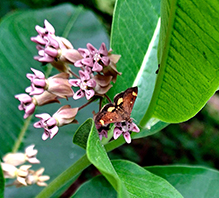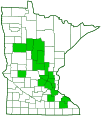Generous pyrausta moth
(Pyrausta generosa)
Conservation • Description • Habitat • Ecology • Distribution • Taxonomy
| Hodges # | 5056 |
||
Conservation Status |
|||
| IUCN Red List | not listed |
||
| NatureServe | NNR - Unranked SNR - Unranked |
||
| Minnesota | not listed |
||
Description |
Generous pyrausta moth is a small mint moth. It occurs in the United States from Pennsylvania to North Carolina, west to Minnesota and eastern Oklahoma. It occurs across southern Canada from Nova Scotia to Alberta. Adults are active from May through August. They are found in undisturbed areas of mixed woodlands and aspen parklands. Little is known of their life history. The larvae have been reported on wild bergamot, and it is thought that one or more other plants in the mint family may also be hosts for the larvae. Moth size is often given in terms of forewing length, which in this case is 5⁄16″ to ⅜″ (8 to 9 mm). The wingspan is 11⁄16″ to 13⁄16″ (18 to 21 mm). With wings closed the overall shape is triangular. The forewings are broad and are often kept spread out when at rest. They are dark brown and blackish brown with black lines and yellow markings. The sub-basal line is thick and deeply jagged. The postmedial line is fine and jagged on the inner third. There is a broad yellow mark extending inward from the leading edge (costal margin), and a squarish yellow patch between the kidney-shaped spot (reniform spot) and the circular spot (orbicular spot). There is usually a broad dark band in the subterminal area, and the terminal band is dark. The fringe is dark at the base, pale or whitish outwards. The hindwings are black or blackish brown with a broad, yellow, postmedial band and a yellow discal spot. |
Size |
Forewing length: 5⁄16″ to ⅜″ (8 to 9 mm) Wingspan: 11⁄16″ to 13⁄16″ (18 to 21 mm) |
Similar Species |
Habitat |
Undisturbed areas of mixed woodlands and aspen parklands. |
Ecology |
Season |
May through August |
Behavior |
Adults come to lights at night and can often be seen resting on vegetation during the day. The wings are held spread out when at rest. |
Life Cycle |
|
Larva Hosts |
Wild bergamot and possibly one or more other plants in the mint family |
Adult Food |
|
Distribution |
||
|
Sources Biodiversity occurrence data published by: Minnesota Biodiversity Atlas (accessed through the Minnesota Biodiversity Atlas Portal, bellatlas.umn.edu, 9/2/2025). |
|
| 9/2/2025 | ||
Occurrence |
||
|
||
Taxonomy |
|
Order |
Lepidoptera (Butterflies and Moths) |
Superfamily |
Pyraloidea (Pyralid and Crambid Snout Moths) |
Family |
Crambidae (Crambid Snout Moths) |
Subfamily |
Pyraustinae |
Tribe |
Pyraustini |
Genus |
Pyrausta (mint moths) |
Section |
Section Pyrausta aurata (generous and orange mint moths and allies) |
Subordinate Taxa |
|
|
|
Synonyms |
|
Botys generosa Pyrausta generosus |
|
Common Names |
|
generous pyrausta moth |
|
Glossary
Costal margin
The leading edge of the forewing of insects.
Orbicular spot
A circular spot or outline in the upper median area near the antemedial line on the forewing of many moths.
Reniform spot
A kidney-shaped spot or outline in the lower median area near the PM line on the forewing of many moths.
Visitor Photos
Share your photo of this insect. |
||
This button not working for you? |
||
Luciearl |
 |
Unknown moth on milkweed. |
MinnesotaSeasons.com Photos
|

Slideshows
|

Visitor Videos
Share your video of this insect. |
||
This button not working for you? |
||
|
Other Videos
|

|
Created: 9/2/2025 Last Updated: © MinnesotaSeasons.com. All rights reserved. |


